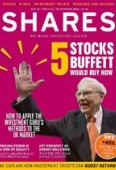Archived article
Please note that tax, investment, pension and ISA rules can change and the information and any views contained in this article may now be inaccurate.
Why pricing power can boost shareholder return

The battle over Marmite pricing between consumer goods giant Unilever (ULVR) and supermarket Tesco (TSCO) is a welcome reminder of why pricing power is one of the key traits of a successful company.
Billionaire investor Warren Buffett says the single most important factor when evaluating a business is pricing power.
‘If you’ve got the power to raise prices without losing business to a competitor, you’ve got a very good business,’ he says.
‘If you have to have a prayer session before raising the price by 10%, then you’ve got a terrible business.’
Price is driving Unilever sales
Unilever’s third quarter numbers (13 Oct) showed 3.2% underlying sales growth driven by price rather than volume.
The company doesn’t necessarily need to shift more goods to drive its sales, but clearly it would be nice to have both higher price and volume.
Unilever is able to charge more for its brands because it knows they are a central part of households across the country – and world.
In particular, Unilever knows that people won’t suddenly stop buying these brands if they become slightly more expensive. That’s because it commands pricing power.
Didn't Tesco win?
In the Tesco case, Unilever was looking to push up prices because weaker sterling is driving up costs – or will do in the near future. It naturally sought to pass this on to the consumer.
The spat was ultimately in neither party’s interest and reports suggest Unilever made some accommodations to get its products back on Tesco’s shelves.
It will not be the last of the consumer goods and food producers to attempt to pass on higher input costs. The likes of Reckitt Benckiser (RB.) and PZ Cussons (PZC) are likely to be doing the same, although whether these negotiations will play out in public is uncertain.
The issues are particularly acute for companies in the groceries sector. Prices have been squeezed by the emergence of discount operators Aldi and Lidl as a major competitive threat.
Secret to bigger returns
‘Pricing power is important because if a firm can charge what it wants to charge it should generate high margins, consistent earnings and robust cash flow,’ says AJ Bell investment director Russ Mould.
‘It can then turn this into the reliable and growing dividends which provide such a large percentage of long-term total shareholder returns, especially once they are reinvested.’
Firms without pricing power – such as producers of commodities like paper, pulp or steel – tend to churn out more volatile earnings and more volatile dividends,’ claims Mould. ‘As a result, their stocks also tend to enjoy lower, long-term trend valuations than those firms with pricing power.’
HOW TO SPOT PRICING POWER
Identifying companies with pricing power is the backbone of a successful long-term stock picking strategy. There there are a number of factors to seek:
1. Brand strength
As the Unilever example demonstrates, strong brands go hand in hand with pricing power.
But brand strength can be quickly lost if a company doesn’t maintain investment in marketing and product development. It can also take a big hit if there is a high profile problem.
Just look at how sentiment has turned against electronics business Samsung (005930:KS) because its phones are bursting into flames.
The Korean firm has been forced to pull the Galaxy Note 7 smartphone off the market due to battery fires at an immediate cost of £4.4bn but with perhaps more lasting damage in terms of the integrity of its brand.
2. Technological edge
A prime example of a company with a technological edge and significant brand power is consumer electronics firm Apple (AAPL:NDQ).
It may have reached saturation point in terms of its smartphone adoption but still retains an enviable ability to charge consumers a significant sum for an upgraded product on an annual or bi-annual basis.
3. Large installed base
It could be argued Apple ticks another box in the pricing power arsenal; a large installed base. Millions of us are tied
to iPhones on at least a two-year upgrade cycle through
our phone network. Many
of us will return to our local Apple store if we encounter technical problems.
A less high profile example of this phenomenon at work is Cheltenham-headquartered Spirax-Sarco Engineering (SPX). The company makes valves and specialist pumps. Steam at high temperatures and pressures is highly erosive. This means parts often need renewing and Spirax sells a significant volume of replacement
products on its large installed base of equipment.
Spirax is well positioned to raise prices because its relatively low cost products (typical invoices are between £1,000 and £50,000) are integral to the machinery used by its customer base. It also enjoys plenty of recurring revenue which underpins earnings visibility and an exceptional track record of dividend growth.
4. Dominant market share
Being the dominant player in a market can also make it easier to ramp up prices without affecting demand.
Property website Rightmove (RMV) is an excellent example. Its website has the most listings, so it is the one most prospective property buyers go to when looking for their next home. This makes it a must-have product for estate agents and results in significant pricing power. (TS)
Important information:
These articles are provided by Shares magazine which is published by AJ Bell Media, a part of AJ Bell. Shares is not written by AJ Bell.
Shares is provided for your general information and use and is not a personal recommendation to invest. It is not intended to be relied upon by you in making or not making any investment decisions. The investments referred to in these articles will not be suitable for all investors. If in doubt please seek appropriate independent financial advice.
Investors acting on the information in these articles do so at their own risk and AJ Bell Media and its staff do not accept liability for losses suffered by investors as a result of their investment decisions.
 magazine
magazine











